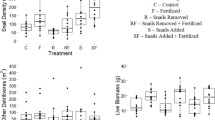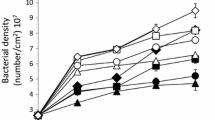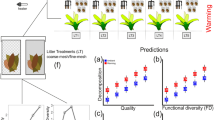Abstract
The cycling and sequestration of carbon are important ecosystem functions of estuarine wetlands that may be affected by climate change. We conducted experiments across a latitudinal and climate gradient of tidal marshes in the northeast Pacific to evaluate the effects of climate- and vegetation-related factors on litter decomposition. We manipulated tidal exposure and litter type in experimental mesocosms at two sites and used variation across marsh landscapes at seven sites to test for relationships between decomposition and marsh elevation, soil temperature, vegetation composition, litter quality, and sediment organic content. A greater than tenfold increase in manipulated tidal inundation resulted in small increases in decomposition of roots and rhizomes of two species, but no significant change in decay rates of shoots of three other species. In contrast, across the latitudinal gradient, decomposition rates of Salicornia pacifica litter were greater in high marsh than in low marsh. Rates were not correlated with sediment temperature or organic content, but were associated with plant assemblage structure including above-ground cover, species composition, and species richness. Decomposition rates also varied by litter type; at two sites in the Pacific Northwest, the grasses Deschampsia cespitosa and Distichlis spicata decomposed more slowly than the forb S. pacifica. Our data suggest that elevation gradients and vegetation structure in tidal marshes both affect rates of litter decay, potentially leading to complex spatial patterns in sediment carbon dynamics. Climate change may thus have direct effects on rates of decomposition through increased inundation from sea-level rise and indirect effects through changing plant community composition.







Similar content being viewed by others
References
Baldwin BG, Goldman DH, Keil DJ, Patterson R, Rosatti TJ, Wilken DH. 2012. The Jepson Manual. Vascular Plants of California. 2nd edn. Berkeley: University of California Press.
Bennion H, Carvalho L, Sayer CD, Simpson GL, Wischnewski J. 2012. Identifying from recent sediment records the effects of nutrients and climate on diatom dynamics in Loch Leven. Freshw Biol 57:2015–29.
Bertness M. 1985. Fiddler crab regulation of Spartina alterniflora production on a New England salt marsh. Ecology 66:1042–55.
Blum LK, Roberts MS, Garland JL, Mills AL. 2004. Distribution of microbial communities associated with the dominant high marsh plants and sediments of the United States east coast. Microb Ecol 48:375–88.
Burke DJ, Hamerlynck EP, Hahn D. 2002. Interactions among plant species and microorganisms in salt marsh sediments. Appl Environ Microbiol 68:1157–64.
Charles H, Dukes JS. 2009. Effects of warming and altered precipitation on plant and nutrient dynamics of a New England salt marsh. Ecol Appl 19:1758–73.
Chevan A, Sutherland M. 1991. Hierarchical partitioning. Am Stat 45:90–6.
Clark CD, Litz LP, Grant SB. 2008. Salt marshes as a source of chromophoric dissolved organic matter (CDOM) to southern California coastal waters. Limnol Oceanogr 53:1923–33.
Craft C. 2007. Freshwater input structures soil properties, vertical accretion, and nutrient accumulation of Georgia and U.S. tidal marshes. Limnol Oceanogr 52:1220–30.
Davidson EA, Janssens IA. 2006. Temperature sensitivity of soil carbon decomposition and feedbacks to climate change. Nature 440:165–73.
Drexler JZ, de Fontaine CS, Brown TA. 2009. Peat accretion histories during the past 6,000 years in marshes of the Sacramento-San Joaquin Delta, CA, USA. Estuaries Coasts 32:871–92.
Duarte B, Velentim JM, Dias JM, Silva H, Marques JC, Caçador I. 2014. Modelling sea level rise (SLR) impacts on salt marsh detrital outwelling C and N exports from an estuarine coastal lagoon to the ocean (Ria de Aveiro, Portugal). Ecol Model 289:36–44.
Griffin D, Anchukaitis KJ. 2014. How unusual is the 2012-2014 California drought? Geophys Res Lett 41:9017–23.
Hackney CT. 1987. Factors affecting accumulation or loss of macroorganic matter in salt marsh sediments. Ecology 68:1109–13.
Halupa PJ, Howes BL. 1995. Effects of tidally mediated litter moisture content on decomposition of Spartina alterniflora and S. patens. Mar Biol 123:379–91.
Happell JD, Chanton JP. 1993. Carbon remineralization in a north Florida swamp forest: effects of water level on the pathways and rates of soil organic matter decomposition. Glob Biogeochem Cycles 7:475–90.
Jackson MB, Armstrong W. 1999. Formation of aerenchyma and the processes of plant ventilation in relation to soil flooding and submergence. Plant Biol 1:274–87.
Janousek CN, Buffington KJ, Thorne KM, Guntenspergen GR, Takekawa JY, Dugger BD. 2016. Potential effects of sea-level rise on plant productivity: species-specific responses in northeast Pacific tidal marshes. Mar Ecol Prog Ser 548:111–25.
Janousek CN, Folger CL. 2014. Variation in tidal wetland plant diversity and composition within and among coastal estuaries: assessing the relative importance of environmental gradients. J Veg Sci 25:534–45.
Jaster T, Meyers SC, Sundberg S (eds). 2016. Oregon Vascular Plant Checklist. Amaranthaceae. http://www.oregonflora.org/checklist.php. Version 1.6.
Jones JA, Cherry JA, McKee KL. 2016. Species and tissue type regulate long-term decomposition of brackish marsh plants grown under elevated CO2 conditions. Estuar Coast Shelf Sci 169:38–45.
Kirwan ML, Guntenspergen GR. 2012. Feedbacks between inundation, root production, and shoot growth in a rapidly submerging brackish marsh. J Ecol 100:764–70.
Kirwan ML, Guntenspergen GR, Langley JA. 2014. Temperature sensitivity of organic-matter decay in tidal marshes. Biogeosciences 11:4801–8.
Kirwan ML, Langley JA, Guntenspergen GR, Megonigal JP. 2013. The impact of sea-level rise on organic matter decay rates in Chesapeake Bay brackish tidal marshes. Biogeosciences 10:1869–76.
Kirwan ML, Megonigal JP. 2013. Tidal wetland stability in the face of human impacts and sea-level rise. Nature 504:53–60.
Ma Z, Ysebaert T, van der Wal D, de Jong DJ, Li X, Herman PMJ. 2014. Long-term salt marsh vertical accretion in a tidal bay with reduced sediment supply. Estuar Coast Shelf Sci 146:14–23.
Mcleod E, Chmura GL, Bouillon S, Salm R, Björk M, Duarte CM, Lovelock CE, Schlesinger WH, Silliman BR. 2011. A blueprint for blue carbon: toward an improved understanding of the role of vegetated coastal habitats in sequestering CO2. Front Ecol Environ 9:552–60.
Mendelssohn IA, Sorrell BK, Brix H, Schierup H-H, Lorenzen B, Maltby E. 1999. Controls on soil cellulose decomposition along a salinity gradient in a Phragmites australis wetland in Denmark. Aquat Bot 64:381–98.
Miller WD, Neubauer SC, Anderson IC. 2001. Effects of sea level induced disturbances on high salt marsh metabolism. Estuaries 24:357–67.
Morris JT, Sundareshwar PV, Nietch CT, Kjerfve B, Cahoon DR. 2002. Responses of coastal wetlands to rising sea level. Ecology 83:2869–77.
Morrissey EM, Gillespie JL, Morina JC, Franklin RB. 2014. Salinity affects microbial activity and soil organic matter content in tidal wetlands. Glob Change Biol 20:1351–62.
Mueller P, Jensen K, Megonigal JP. 2016. Plants mediate soil organic matter decomposition in response to sea level rise. Glob Change Biol 22:404–14.
National Research Council. 2012. Sea-level rise for the coasts of California, Oregon, and Washington: past, present, and future. Washington D.C: The National Academies Press.
Neubauer SC. 2008. Contributions of mineral and organic components to tidal freshwater marsh accretion. Estuar Coast Shelf Sci 78:78–88.
Nyman JA, Walters RJ, Delaune RD, Patrick WH Jr. 2006. Marsh vertical accretion via vegetative growth. Estuar Coast Shelf Sci 69:370–80.
Oksanen J. 2015. Multivariate analysis of ecological communities in R: vegan tutorial. http://cc.oulu.fi/~jarioksa/opetus/metodi/vegantutor.pdf. Accessed 22 Jan 2016.
Page HM. 1997. Importance of vascular plant and algal production to macro-invertebrate consumers in a southern California salt marsh. Estuar Coast Shelf Sci 45:823–34.
Scavia D, Field JC, Boesch DF, Buddemeier RW, Burkett V, Cayan DR, Fogarty M, Harwell MA, Howarth RW, Mason C, Reed DJ, Royer TC, Sallenger AH, Titus JG. 2002. Climate change impacts on U.S. coastal and marine ecosystems. Estuaries 25:149–64.
Shao X, Yang W, Wu M. 2015. Seasonal dynamics of soil labile organic carbon and enzyme activities in relation to vegetation types in Hangzhou Bay tidal flat wetland. PLoS ONE 10:e0142677.
Swanson KM, Drexler JZ, Schoellhamer DH, Thorne KM, Casazza ML, Overton CT, Callaway JC, Takekawa JY. 2014. Wetland accretion rate model of ecosystem resilience (WARMER) and its application to habitat sustainability for endangered species in the San Francisco estuary. Estuaries Coasts 37:476–92.
Taylor BR, Parkinson D, Parsons WFJ. 1989. Nitrogen and lignin content as predictors of litter decay rates: a microcosm test. Ecology 70:97–104.
Thorne KM, Dugger BD, Buffington KJ, Freeman CM, Janousek CN, Powelson KW, Guntenspergen GR, Takekawa JY. 2015. Marshes to mudflats—effects of sea-level rise on tidal marshes along a latitudinal gradient in the Pacific Northwest. U.S. Geological Survey Open-file Report 2015–1204.
Thorne KM, MacDonald GM, Ambrose RF, Buffington KJ, Freeman CM, Janousek CN, Brown LN, Holmquist JR, Guntenspergen GR, Powelson KW, Barnard PL, Takekawa JY. 2016. Effects of climate change on tidal marshes along a latitudinal gradient in California. U.S. Geological Survey Open-file Report 2016–1125.
Twilley RR, Ejdung G, Romare P, Kemp WM. 1986. A comparative study of decomposition, oxygen consumption and nutrient release for selected aquatic plants occurring in an estuarine environment. Oikos 47:190–8.
Weinmann F, Zika PF, Giblin DE, Legler B. 2002+. Checklist of the vascular plants of Washington state. University of Washington Herbarium. http://biology.burke.washington.edu/herbarium/waflora/checklist.php. Accessed 30 Jan 2017.
White DA, Trapani JM. 1982. Factors influencing disappearance of Spartina alterniflora from litterbags. Ecology 63:242–5.
Windham L. 2001. Comparison of biomass production and decomposition between Phragmites australis (common reed) and Spartina patens (salt hay grass) in brackish tidal marshes of New Jersey, USA. Wetlands 21:179–88.
Yuan J, Ding W, Liu D, Kang H, Xiang J, Lin Y. 2016. Shifts in methanogen community structure and function across a coastal marsh transect: effects of exotic Spartina alterniflora invasion. Sci Rep 6:18777.
Zhang LH, Tong C, Marrs R, Wang TE, Zhang WJ, Zeng CS. 2014. Comparing litter dynamics of Phragmites australis and Spartina alterniflora in a sub-tropical Chinese estuary: contrasts in early and late decomposition. Aquat Bot 117:1–11.
Acknowledgments
Funding for this study was provided by the U.S. Department of the Interior Southwest and Northwest Climate Science Centers, the U.S. Geological Survey DOI on the Landscape Program, the Ecosystems and Climate and Land-use Research and Development programs of the U.S. Geological Survey, and Oregon State University. We thank Tristan Edgarian, Craig Cornu, Jenni Schmitt, Patrick Brennand, Yareli Sanchez, Lennah Shakeri, Laura Hollander, Ari Goodman, Sierra Blakely, Chase Freeman, Jimmie Lambert, Dave Nelson, Mee-ya Monnin, and Jordan Rosencranz for their valuable assistance with this project. The U.S. Fish and Wildlife Service, NOAA’s South Slough National Estuarine Research Reserve, U.S. Navy, California State Parks, and California Department of Fish and Wildlife kindly permitted access to the research sites. We thank J. Jones and two anonymous reviewers for comments that improved the manuscript. Any use of trade, product, or firm names in this publication is for descriptive purposes only and does not imply endorsement by the U.S. government. The findings and conclusions in this article are those of the authors and do not necessarily represent the views of the SWCSC or NWCSC. This manuscript is submitted for publication with the understanding that the U.S. Government is authorized to reproduce and distribute reprints for governmental purposes.
Author information
Authors and Affiliations
Corresponding author
Additional information
Author contributions C.J., G.G., J.T., and K.T. designed the study; C.J., K.B., and B.D. conducted field work; C.J. analyzed the data; C.J. wrote the paper, K.B. produced Fig. 1, and all authors helped revise the paper.
Janousek, C.N., Buffington, K.J., Guntenspergen, G.R., Thorne, K.M., Dugger, B.D., and Takekawa, J.Y., 2017, Decomposition of plant litter in Pacific coast tidal marshes, 2014–2015: U.S. Geological Survey data release, http://doi.org/10.5066/F70P0X6C.
Electronic supplementary material
Below is the link to the electronic supplementary material.
Rights and permissions
About this article
Cite this article
Janousek, C.N., Buffington, K.J., Guntenspergen, G.R. et al. Inundation, Vegetation, and Sediment Effects on Litter Decomposition in Pacific Coast Tidal Marshes. Ecosystems 20, 1296–1310 (2017). https://doi.org/10.1007/s10021-017-0111-6
Received:
Accepted:
Published:
Issue Date:
DOI: https://doi.org/10.1007/s10021-017-0111-6




